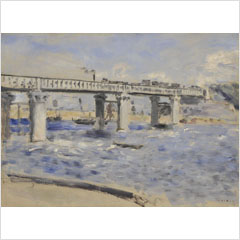
オーギュスト・ルノワール
アルジャントゥイユの橋
1873年 油彩・カンヴァス 46.0×63.0cm
Pierre-Auguste Renoir
The Railway Bridge at Argenteuil
Pont du chemin de fer à Argenteuil
1873, Oil on Canvas, 46.0 × 63.0 cm
鉄橋が架かるセーヌ川の様子が自由なタッチで描かれています。川面は短い平筆のタッチでリズミカルに塗られて、その感覚はセーヌ川を吹き抜ける風を想像させるかのようです。鉄橋の影の灰色は光と影のグラデーションではなく、色の面としてあらわされており、川面に盛り上げられた白い絵具とともに降り注ぐ陽光の瞬きが感じられます。
この時期、ルノワールはしばしばアルジャントゥイユに住むモネを訪ねて、ともに制作をしました。二人は戸外にイーゼルを立てて同じ風景を描き、「筆触分割」によって色彩で画面を構成する新しい絵画を模索しました。こうした作品は翌年に開催される「第1回印象派展」に出品され、大きな反響を呼びました。自由な感覚に満ちたこの風景画は、印象派の誕生を象徴する作品の一つといえるでしょう。
The scene of the Seine River with the railway bridge is depicted with a free touch. The river surface is painted rhythmically with short, flat brushstrokes, evoking the sensation of the wind blowing across the Seine. The gray shadows of the bridge are represented as color planes rather than gradients of light and shadow, and along with the raised white paint on the river surface, they convey the flickering sunlight.
During this period, Renoir often visited Monet, who lived in Argenteuil, and they painted together. They set up their easels outdoors and painted the same landscapes, exploring a new style of painting that constructed the canvas with color through "divided brushstrokes." These works were exhibited at the "First Impressionist Exhibition" held the following year, which garnered significant attention. This landscape painting, filled with a sense of freedom, can be considered one of the works symbolizing the birth of Impressionism.

